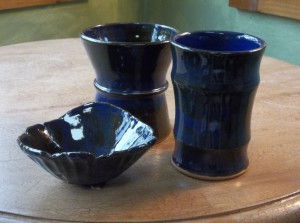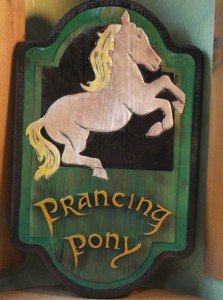 Sean Robinson has two passions that have recently found their way together in a most amazing fashion. Sean discovered his passion for pottery in 2007 – a hobby that sprang from his love of several different arts. He is also a huge fan of the works of J.R.R. Tolkien – a love, I think, we can all appreciate. Working from his pottery studio in Jamestown, NC, Sean spends his free time crafting many fine objects.
Sean Robinson has two passions that have recently found their way together in a most amazing fashion. Sean discovered his passion for pottery in 2007 – a hobby that sprang from his love of several different arts. He is also a huge fan of the works of J.R.R. Tolkien – a love, I think, we can all appreciate. Working from his pottery studio in Jamestown, NC, Sean spends his free time crafting many fine objects.
Most recently, his works have taken on the form of some very recognizable objects
from the lands of Middle-earth. It began in the most unexpected way for Sean – with
his father, Bill Robinson, indulging him in his appreciation for Tolkien’s stories. This
took the form of some intricately constructed wooden signs as seen in Peter Jackson’s films – one for The Prancing Pony in Bree, and the other for The Green Dragon in the Shire.
I had the wonderful opportunity to sit down with Sean and ask him about his work and how his father’s projects led to a collaboration in creating other artifacts from the world of Professor Tolkien.
Aragorn the Elfstone: Sean, what inspired you to begin your pottery work?
Sean: Pottery for me began as something ‘to do’. I have dabbled in drawing, painting and enjoyed sculpture. My first degree from college was special make-up effects (my dream career), but life was to take me a different direction. Years later, I took a pottery class at a community art school and really found a love and a small amount of skill for clay and the wheel-throwing process. A year after that, I took another pottery class the week before I deployed to Iraq with the US Army. 14 months later, upon my return, I wanted to continue my education at university where I immersed myself in ceramics classes. I love the creation process that clay allows. In 2008 I acquired my own
electric wheel and have slowly built up a hobbyist pottery studio with a kiln, some glazes, tools and a kick wheel. I believe the real inspiration for me is to create works of art that will be used and appreciated on a daily basis. External inspiration comes from my research of master potters, historical pieces and the visions of Tolkien and Peter Jackson.
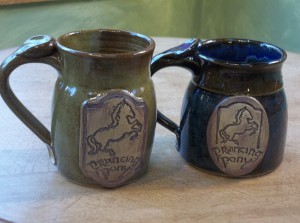 Aragorn the Elfstone: How long does each of your projects take?
Aragorn the Elfstone: How long does each of your projects take?
Sean: Each project has its own time frame of when it can be finished. There are many steps in creating a pot (my generic term for anything created in my pottery studio. A bowl or mug or plate can be a ‘pot’).
Some forms, like a bowl can be thrown in minutes. Other pieces like an intricate vase or a lidded vessel with handles can take much longer. The process is manifold. Allow me to use the Prancing Pony mug as an example. First I weigh out a ball of clay, say ¾ of a pound for a mug. I throw the form of the mug on the wheel, which itself takes 5-10 minutes. The clay must dry to the point of being almost leather-hard. I put the form back on the wheel and I trim the bottom of the mug if I need to refine the shape. I set the mug aside and pull a handle for it from a lump of clay. I attach the handle to the mug and set the whole thing aside again, keeping it covered with plastic to retain its moisture content. If a piece dries out too much before it is finished, it is nigh impossible to attach anything to it or modify the form.
Next I roll out a thin slab of clay, dust it with cornstarch and use the Prancing Pony stamp my father made for me to stamp the image into the slab. The cornstarch keeps the clay from sticking to the stamp. I refine the stamped slab and attach it to the mug. The long slow process of drying now comes into play. If a piece of pottery with multiple attachments (handles, slabs, knobs, embellishments, etc) dries too fast, the attachments may crack at the joint. Once the piece is bone dry I can bisque fire it. Bisque firing chemically removes all moisture from the pot and changes the clay body to a stone-like quality. The bisque fire takes about 24 hours for my kiln to get up to about 1830 degrees F and to cool down. Once the bisque is finished, I choose and apply a glaze to the mug, an oxide wash for the stamped image and fire the pot again, this time to 2185 degrees for another 24 hours. This second firing sets the glaze onto the pot. If I have done all these steps correctly and in their own time, I will have an amazing mug to drink from once I allow my kiln to cool.
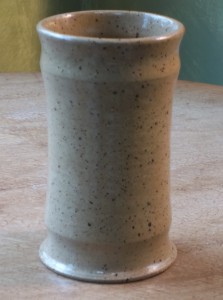 My studio is semi-air conditioned in the summer and only lightly heated in the winter. Weather plays a big role on the body of the clay and how long it takes to dry a pot for firing. Sometimes I can go from start to finish on a pot in a few days, other times it can take weeks.
My studio is semi-air conditioned in the summer and only lightly heated in the winter. Weather plays a big role on the body of the clay and how long it takes to dry a pot for firing. Sometimes I can go from start to finish on a pot in a few days, other times it can take weeks.
I once heard a man ask a master potter why he charges so much money for a pot that takes him only 20 minutes to make. The potter replied because it takes him 20
minutes and 20 years to create a pot.
Aragorn the Elfstone: Tell me a bit about your love of Tolkien and how it began.
Sean: Rankin and Bass’ animated film ‘The Hobbit’ was a wonderful place to begin my appreciation for Tolkien. As a young person, I remember sheer entertainment of watching such a fantastic adventure. Later I find that there is not only a book from which the movie was based, but there is an entire universe of lore. It was not until a few years ago, after reading The Hobbit and The Lord of the Rings a few times each, that I decided to tackle The Silmarillion. It was only after that reading experience that I realized the absolute depth of Tolkien’s Middle-earth. It is immense and detailed and I love to explore it. I am amazed how Tolkien is able to give life to everything in his world. One of my favorite details is the seemingly throw away line by Aragorn in The Fellowship of the Ring referencing the Cats of Queen Berúthiel. It is not until years later that Tolkien gives us a history of the cats and their queen. Why would Tolkien care do this with such an off-hand comment? Clearly it was not a throw away line. They have a history and a place in Middle-earth. It is the details and the realism that Tolkien presents that allows his readers to immerse themselves in a world that becomes familiar.
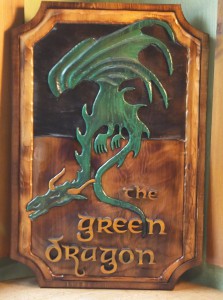 Aragorn the Elfstone: Your father surprised you with some absolutely wonderful Middle-earth road signs. What prompted him to begin that work, and what was your reaction when you saw it?
Aragorn the Elfstone: Your father surprised you with some absolutely wonderful Middle-earth road signs. What prompted him to begin that work, and what was your reaction when you saw it?
Sean: If I remember correctly, my father created the Prancing Pony sign based off the stamp design without prompting. He just scaled up the stamp image to 11 x 17 inches and used his magic cutting machine to create the design out of wood (the stamp is made from acrylic). He called me and said his foray into ‘garden signs’ was on the way and I should be on the lookout for the mailman. When my wife and I opened the box with the Prancing Pony sign in it we were floored. We had no idea what to expect and when we saw it we just said “Wow! Oh my goodness. Wow!” I called my dad immediately to thank him and he said it was his first attempt at a sign. I told him we were amazed. I do not believe the photos do the signs justice. They are textured and detailed and constructed with a level of craftsmanship that any hardcore Middle-earth fan would appreciate. The Green Dragon sign followed a few months later and my wife and I were equally pleased and amazed with it. They are both proudly displayed in our kitchen.
Aragorn the Elfstone: When and how did the idea for the mugs come about?
Sean: It was my request that my father make the Prancing Pony stamp for the mugs. Here is how it came about; my father lives in a small town in west Texas and he displays his incredible woodworking skills at a local coffee shop called Jitter Bean. The owners of the shop wanted handmade mugs with their logo stamped on the side to sell to the locals and the tourists. My father made the Jitter Bean stamp for me and I knocked out about a dozen mugs for the shop. They seem to sell well, in fact they may be sold out by now (I guess it’s back to the studio to replenish their stock of Jitter Bean mugs). I thought if we can do a mug for a coffee shop, can we do a mug for the local watering holes in Middle-earth? The Prancing Pony stamp was based off the Weta designs we found online.
Aragorn the Elfstone: And how did you feel working with your dad on them?
Sean: I was extremely happy to work with my father on this project. He is an incredibly talent artist and a great father. I believe we would collaborate more on Tolkien-related projects (or any projects) if I lived closer to him. My wife and I have numerous decorative boxes (both wood, stained glass and a combination of the two), signs, furniture pieces and art around our home that my father has created for us. My father and I usually trade wood projects for pottery between the two of us. One thing that I think is kind of neat is that he replicated Sting out of wood years before we saw the extended scene of young Bilbo swatting Gandalf with his little wooden sword in The Hobbit. I am not sure if he made another one but I researched the engravings on Bilbo’s sword, translated them (with lots of internet help) and sent my father the images. This was with the hopes he might recreate the wooden sword and wood-burn the elvish words onto the blade. No sword yet. But I am sure that with a little convincing we could all make this happen.
Aragorn the Elfstone: What are your plans for future work?
Sean: Future work includes updating my blog http://functionalmud.wordpress.com/ with more of my most recent pieces of pottery. I have a wait list about a mile long that I did not get to for Christmas gifts for the family. I have dinner sets with hand built plates and bowls on the drawing board that will compliment the ‘Gandalf’ cups seen on my website. I have a local organic grocer near my home and they have made requests for personalized mugs. I’ve made about 10 for them and have two more to finish before too long. Mostly it’s about getting out into the studio and keeping my skills up and experimenting with new techniques and challenging myself. My ultimate goal is to generate sales of my pottery from my website.
Aragorn the Elfstone: Do you think you’ll do more Tolkien-related work?
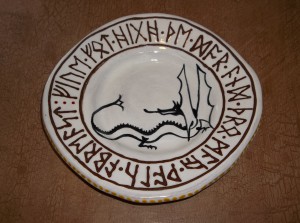 Sean: I will most definitely do more Tolkien-related pottery projects.
Sean: I will most definitely do more Tolkien-related pottery projects.
Beorn had some rustic looking pots I would like to replicate and Bilbo’s home was filled with great looking pieces. I have seen online where you can buy a replica of ‘Bilbo’s teapot and mugs’. The pieces look great and then I think “wait, I will make those for myself”. The plate I created with images from Thror’s map was a fun challenge. I have plans to create another one with a gold luster to accent to coins I painted around the
edge of the plate. I am taking screen shots from The Lord of the Rings and The Hobbit films to see the pottery used in some scenes. The cup Gandalf uses when he is researching the history of Isildur and the One Ring at Minas Tirith is a fun piece to make. My goal is to replicate or at least be inspired to create down-home, earthy, hand-made pottery that will last for generations.
You can find more photos of Sean’s work and follow future updates at his website Functional Mud.



